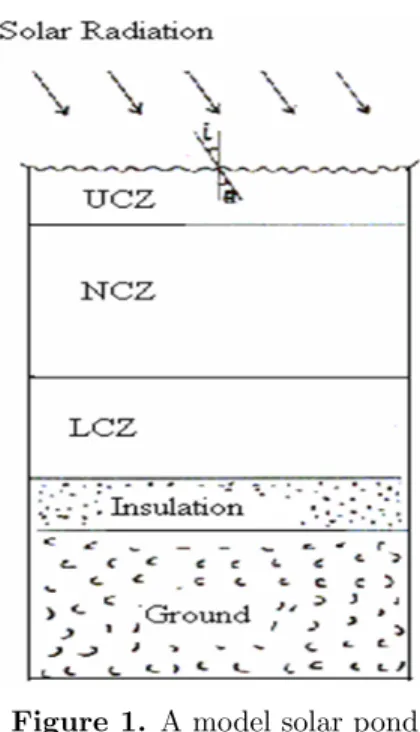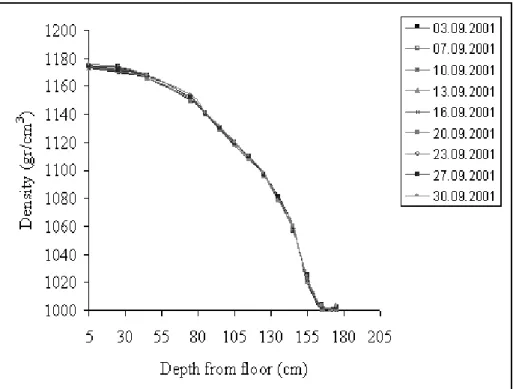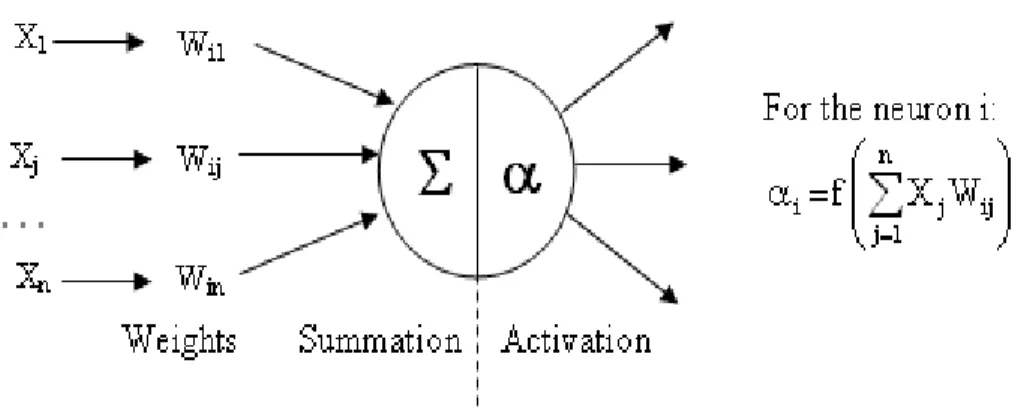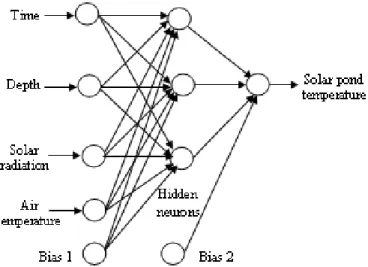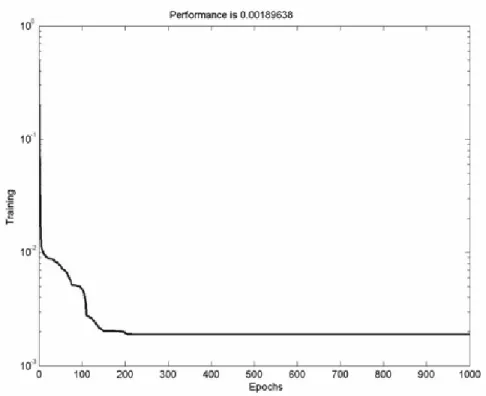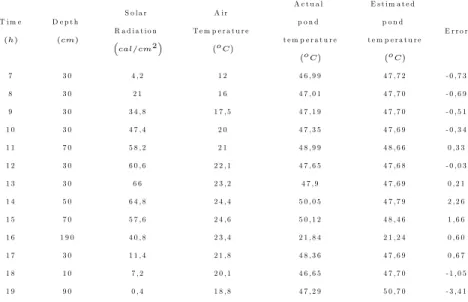Selçuk J. Appl. Math. Selçuk Journal of Vol. 5. No.2. pp. 33-41, 2004 Applied Mathematics
A New Formulation to Estimate Temperature of Solar Pond Arzu ¸Sencan1and Nalan Çiçek Bezir2
Department of Mechanical Education, Technical Education Faculty, Süleyman Demirel University, 32260, Isparta, Turkey;
e-mail:sencan@ tef.sdu.edu.tr
Department of Physics, Science-Literature Faculty, Süleyman Demirel University, 32260, Isparta, Turkey;
e-mail:cicek@ fef.sdu.edu.tr
Received : September 30, 2004
Summary.In this paper, a new formulation based on Arti…cial Neural Network (ANN) was presented for estimating solar pond temperature. Temperature of solar pond which is constructed experimentally was estimated depending on time, pond depth, solar radiation and air temperature. In order to train the network, experimental measurements were used as training and test data. The temperatures in di¤erent depths of solar pond have been calculated theoretically with equations derived from ANN model and compared with the experimental results. The ability of ANN is to learn complex non-linear relationships. A new formulation using ANN was presented here.
Key words: Solar ponds, Arti…cial Neural Network, Solar energy, Mathemat-ical formulation.
1. Introduction
Solar ponds provide inexpensive means for collecting and storing solar energy at temperatures below 90oC [1]. A salt gradient solar pond consists of three distinct zones as shown Figure 1. The …rst zone, called the upper convecting zone (UCZ) and situated on the top of the pond, is a zone of absorption and transmission. The second zone, called non-convecting zone (NCZ), is situated below the UCZ. The third zone, called the lower convecting zone (LCZ), is
Figure 1. A model solar pond
Some theoretical studies on solar ponds were also done. Some of the most im-portant of these are the Weinberger [4],Rabl and Nielsen [5],Hull [6],Brinkworth and Hawladers [7] analytical studies on establishing temperature distribution in solar ponds.
The …rst scienti…c study on solar ponds in our country was done in 1978 by Kayal¬[8] with a small, uninsulated solar ponds whose dimensions were 4.5 m x 4.5m x 1.5 m. In this study Kayal¬ [8] did the physics, modelling and economical analysis; it was noticed that the output for this uninsulated pond was about 16%, and the cost of solar ponds were 2.5 times cheaper than ‡at-plate collectors that produce hot water from solar energy. This study also proved that maintenance and reparation were quite easy [8].
In this study, temperatures of a salt gradient and insulated solar pond which is constructed experimentally were estimated with equations derived from ANN. 2. Experimental study
An experimental pond having an area of 12.25 m2 and a depth of 2 m was constructed at Isparta Yalvaç High School Campus area. In order to ensure isolation, bottom and sides of solar pond were insulated very well [3]. The pond was …lled with salty water in the di¤erent densities. Densities at various depths of pond for September are shown in Figure 2.
Figure 2. Densities at various depths of pond
In order to do temperature measurement, LM35 diodes are used as detector and the top of these diodes are covered with silicon in order not to be a¤ected from salty water. To be used in temperature measurement diodes calibrations are done. Ten of the diodes, whose calibrations are done, are placed from below to above in the pond, two of them into the bottom concrete. The analogue data that comes from these detector diodes is registered in a computer, transforming digital temperature data by means of an AD/DA transformer and the diagrams that give the temperature distribution versus time are obtained by the Excel programme [3].
3. Arti…cial Neural Networks
The best example of a neural network is probably the human brain. In fact, the human brain is the most complex and powerful structure known today. Arti…cial neural networks are composed of simple elements operating in parallel. These elements are inspired by biological nervous systems. The ANN modeling is carried out in two steps; the …rst step is to train the network whereas the second is to test the network with data, which were not used for training. The unit
3 illustrates how information is processed through a single node. The node receives weighted activation from other nodes through its coming connections. First, these are added (summation function). The result is then passed through an activation function, the outcome being the activation of the node. For each of the outgoing connections, this activation value is multiplied with the speci…c weight and transferred to the next node.
Figure 3. Information processing in an arti…cial neural network unit.
A training set is a group of matched input and output patterns. This is used for the training of the network, usually by suitable adaptation of the synaptic weights. The outputs are the dependent variables that the network produces for the corresponding input. It is important that all the information the network needs to learn is supplied to the network as a data set. When each pattern is read, the network uses the input data to produce an output, which is then compared to the training pattern, i.e. the correct or desired output. If there is a di¤erence, the connection weights (usually but not always) are altered in such a direction that the error is decreased. After the network has run through all the input patterns, if the error is still greater than the maximum desired tolerance, the ANN runs through all the input patterns repeatedly until all the errors are within the required tolerance. When the training reaches a satisfactory level, the network holds the weights constant and the trained network can be used to make decisions, identify patterns, or de…ne associations in new input data sets not used to train it [12-17].
4. Case study
Temperatures of solar pond which is constructed experimentally were estimated depending on time, pond depth, solar radiation and air temperature. In the experiments, the temperature in 10, 30, 50, 70, 90, 110, 130, 150 and 190 cm depth were measured with censors. In this study, data sets included 117 data. These data sets are obtained from experimental measurements [3]. For training step, 92 data were selected, and for testing 25 data were selected.
Log-sigmoid transfer function was used as the activation function for hidden layers and output layers. The values of the training and test data were normal-ized to within the range from 0 to 1. Levenberg-Marquardt Back-propagation Training was repeatedly applied until the evaluation standard was reached.
As was proven by Bezir et. al., most optimal topology was determined as the con…guration 4-3-1 [18]. The con…guration is shown in Figure 4. Time, pond depth, solar radiation and air temperature were chosen as input. For output layer, pond temperature was chosen.
Figure 4. ANN model used in application
The decrease of the mean square error (MSE) during the training process is shown in Figure 5. Regression between experimental and simulating data was determined. Regression value obtained is 0.98, which is very satisfactory [18].
Figure 5. Training results based on the 4-3-1 con…guration 5. Formulations from the case study
Mathematical formulations can be derived using result weights and used activa-tion funcactiva-tions from ANN because regression values of training and test results are highly good. Ei (summation function of neuron i) and Fi (activation func-tion of neuron i) values were obtained so that weight values are substituted in summations and activation functions in each neuron belong to hidden layer because developed model in the Case study is in con…guration of model 4-3-1. Activation function was chosen log-sigmoid as shown from Fi function. In the output neuron, only one summation function is used as only one output para-meter exists which corresponds to solar pond temperature. In the model, the inputs of the network are time (t), depth (h), solar radiation (R), air tempera-ture (T0) and the output is solar pond temperature. To estimate the solar pond temperature using Case Study, the following formulations can be used:
(1) t1= t=20
(2) h1= h=200
(4) T01= T0=25 (5) E1= t1(0:26506) + h1(12:8213) + R1(0:29569) + T01( 1:1324) 6:1131 (6) F1= 1 1 + e E1 (7) E2= t1(0:18296) + h1(11:9886) + R1(0:25671) + T01( 0:88443) 6:2341 (8) F2= 1 1 + e E2 (9) E3= t1(19:0997) + h1( 4:0679) + R1(4:7587) + T01(20:2677) + 0:41133 (10) F3= 1 1 + e E3
In the above equations for Ei the …rst two values are the multiplication of the input parameters with their weights at location i and the last constant value represent the bias term. Thus the terms E1 to E3and F1 to F3 represent sum-mation and activation functions of each neuron of the hidden layer, respectively. Equations (1-4) are used to convert the actual input data of time, depth, solar radiation and ambient temperature to normalized values in the range [0-1]. Fi-nally, the temperature of solar pond depending on time, depth, solar radiation and air temperature can be computed from:
(11) E4= F1(13:9789) + F2( 16:3191) + F3( 11:1573) + 12:9099
(12) Solar pond temperature = 1
1 + e E4:56
The coe¢ cient shown in (12) is used to convert the normalized output to actual output (solar pond temperature).
In Table 1 a comparison is presented between the experimental measurement temperature and temperature estimated with the equations derived from ANN of solar pond. As can be seen the error is very small.
T i m e (h) D e p t h (cm) S o l a r R a d i a t i o n cal=cm2 A i r T e m p e r a t u r e o C A c t u a l p o n d t e m p e r a t u r e o C E s t i m a t e d p o n d t e m p e r a t u r e o C E r r o r 7 3 0 4 , 2 1 2 4 6 , 9 9 4 7 , 7 2 - 0 , 7 3 8 3 0 2 1 1 6 4 7 , 0 1 4 7 , 7 0 - 0 , 6 9 9 3 0 3 4 , 8 1 7 , 5 4 7 , 1 9 4 7 , 7 0 - 0 , 5 1 1 0 3 0 4 7 , 4 2 0 4 7 , 3 5 4 7 , 6 9 - 0 , 3 4 1 1 7 0 5 8 , 2 2 1 4 8 , 9 9 4 8 , 6 6 0 , 3 3 1 2 3 0 6 0 , 6 2 2 , 1 4 7 , 6 5 4 7 , 6 8 - 0 , 0 3 1 3 3 0 6 6 2 3 , 2 4 7 , 9 4 7 , 6 9 0 , 2 1 1 4 5 0 6 4 , 8 2 4 , 4 5 0 , 0 5 4 7 , 7 9 2 , 2 6 1 5 7 0 5 7 , 6 2 4 , 6 5 0 , 1 2 4 8 , 4 6 1 , 6 6 1 6 1 9 0 4 0 , 8 2 3 , 4 2 1 , 8 4 2 1 , 2 4 0 , 6 0 1 7 3 0 1 1 , 4 2 1 , 8 4 8 , 3 6 4 7 , 6 9 0 , 6 7 1 8 1 0 7 , 2 2 0 , 1 4 6 , 6 5 4 7 , 7 0 - 1 , 0 5 1 9 9 0 0 , 4 1 8 , 8 4 7 , 2 9 5 0 , 7 0 - 3 , 4 1
Table 1. Comparison between the experimental measurement temperature and temperature estimated with the equations derived from ANN of solar
pond.
6. Conclusion
ANN is especially appropriate for investigating complex problem. Many non-linear engineering problems can be formulised using this methodology.
In this paper, The ANN is successfully applied to estimate of solar pond temper-ature. The regression value (R2–value) is about 0.98, which can be considered as very satisfactory. In order to estimate of solar pond temperature, mathemat-ical formulations were derived from the ANN model. Formulations of the model have been obtained from formulations of selected functions (i.e. summation and activation) used in the ANN model and weights of neurons. The results ob-tained from the study show that the ANN model could be used successfully on estimating the temperature in di¤erent depths in a solar pond.
References
1. Rivera, W., Romero, R.J.(2000): Evaluation of heat transformer powered by a solar pond. Solar Energy Materials and Solar Cells ; 63:413-422.
2. Hassairi, M., Sa…, M.J., Chibani, S. (2001): Natural brine solar pond: an experi-mental study. Solar Energy; 70(1):45-50.
3. Çiçek B. N. (2002): Applications and storage of solar energy in solar ponds. PhD thesis, University of Süleyman Demirel, Turkey, Hawlader, M.N.A., Brinkworth, B.J. An
4. Weinberger, H.(1964): The physics of the solar pond. Solar Energy; Vol 8, No3. 5. Rabl, A., ve Nielsen, E. (1974): Solar ponds for space heating, Solar Energy; Vol 17, pp1-12, Great Britain.
6. Hull, J.R.(1980): Computer simulation of solar pond thermal behaviour, Solar
Energy; Vol 25, pp 33-40, Britain.
7. Hawlader, M.N.A., Brinkworth, B.J.(1981): An analysis of the non convecting solar pond, Solar Energy, Vol 27, No 3, pp. 195-294, Great Britain.
8. Kayal¬, R. (1980): Experimental solar pond in Çukurova area and observation of various parameters, Ç.Ü. Science Science Institute, Master thesis, 63p.
9. Fu, L.M.(1994): Neural Networks in Computer Intelligence, Mc Graw-Hill Interna-tional Editions.
10. Tsoukalas, L.H., Uhrig, R.E.(1997): Fuzzy and Neural Approaches In Engineering, John Wiley&Sons Inc.
11. Lin, C.T., Lee, C.S.G. (1996): Neural fuzzy systems, PTR Prentice Hall.
12. Kalogirou, S.A.(1999): Applications of arti…cial neural networks in energy systems A review, Energy Conversion & Management, 40:1073-1087.
13. Kalogirou, S. A.(2000): Arti…cial neural networks in renewable energy systems applications: a review, Renewable and Sustainable Energy Reviews, 5, 373–401. 14. Kalogirou, S. A.(2000): Applications of arti…cial neural networks for energy sys-tems, Applied Energy, 67, 17-35.
15. Kalogirou, S. A.(2000): Long-term performance prediction of forced circulation solar domestic water heating systems using arti…cial neural networks, Applied Energy, 66, 63–74.
16. Kalogirou, S. A.(1999): Panteliou, S., Dentsoras, A., Arti…cial neural networks used for the performance of a thermosyphon solar water-heater, Renew. Energy, 18, 87-99.
17. Kalogirou, S. A., Bojic, M.(2000): Arti…cial neural networks for the prediction of the energy consumption of a passive-solar building, Energy, 25, 479-491.
18. Bezir, N.Ç., ¸Sencan, A., Özek, N., Yakut, A.K.(2004): Estimation of solar pond
temperatures using arti…cial neural network, Selçuk Journal of Applied Mathematics, 5(1), 39-48.
